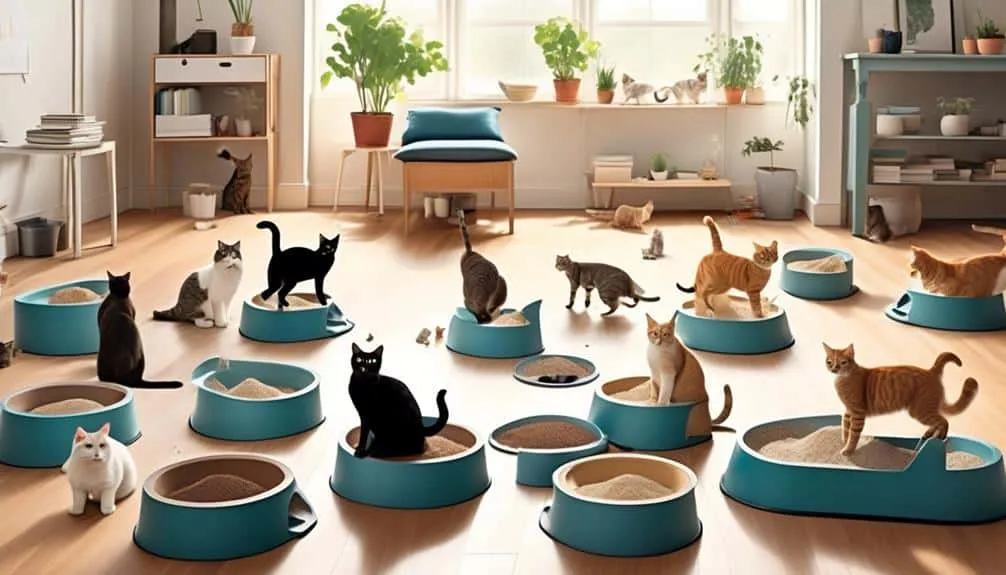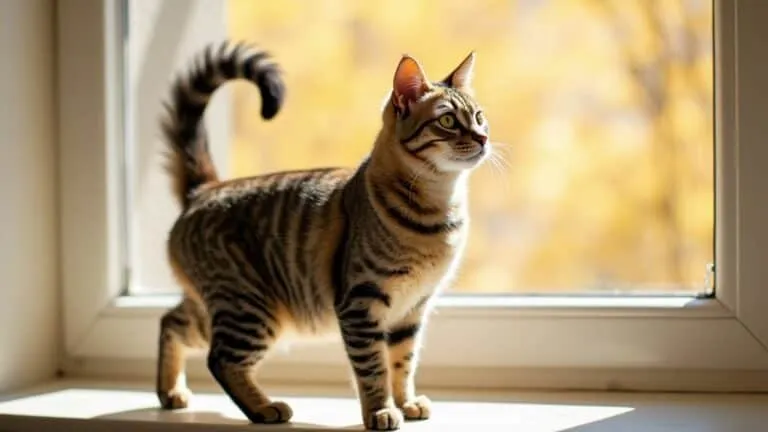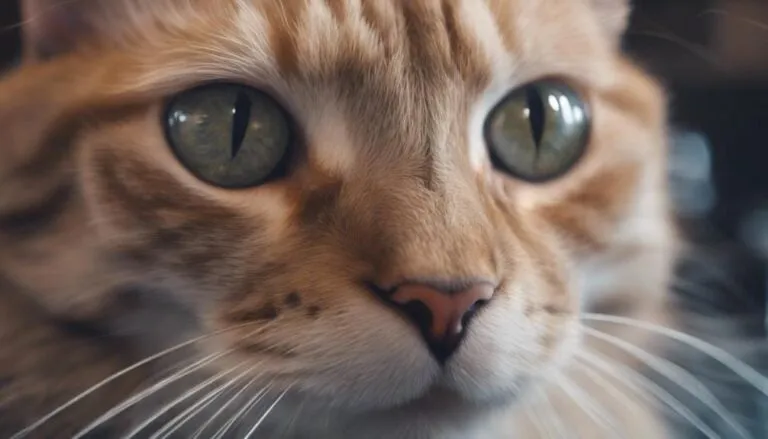The Best Fluffy Pancakes recipe you will fall in love with. Full of tips and tricks to help you make the best pancakes.

Have you ever found yourself scratching your head in confusion as you observe your feline companion's peculiar bathroom habits? It's as if they have a secret code, a hidden language that only they understand.
Well, fear not, because in this article, we will unlock the mystery behind a controversial cat behavior that has left many cat owners perplexed: the need for multiple litter boxes.
You may be surprised to discover the fascinating reasons behind this behavior, and how it can significantly impact your cat's well-being.
So, prepare to embark on a journey of understanding as we delve into the world of multiple litter boxes and reveal the secrets that lie within.
Key Takeaways
- Cats prefer different litter boxes for different outputs, such as using one box for poops and another for pee.
- Cats are territorial creatures, and multiple litter boxes placed close together may be seen as one territory.
- Providing multiple litter boxes ensures that cats have a safe and stress-free place to potty.
- It is generally not a good practice for cats to share litter boxes, as it can lead to conflicts and stress.
Why Cats Need Multiple Litter Boxes
To ensure your cats have a clean and stress-free bathroom experience, it's important to provide them with multiple litter boxes.
Cats are known for their hygiene, and having multiple litter boxes allows them to maintain cleanliness. Additionally, some cats prefer different litter boxes for different outputs, such as using one box for poops and another for pee. This behavior has been reported by many cat owners and is interesting to study further.
Cats are also territorial creatures, and having multiple litter boxes helps create separate territories for each cat. This reduces the chances of conflicts and stress. Moreover, providing multiple litter boxes ensures that cats always have a safe and suitable place to potty, promoting their overall well-being.
When it comes to litter box hygiene, having multiple litter boxes is essential for maintaining cleanliness and avoiding litter box issues. Additionally, if your cat doesn't prefer traditional litter boxes, there are various litter box alternatives available in the market that you can explore.
Cats Prefer Different Litter Boxes for Different Outputs
Cats have been observed to exhibit a preference for using different litter boxes for different outputs. This interesting behavior has been reported by many cat owners and is worth exploring further. Here are four key points to consider regarding cats' preferences for different litter boxes:
- Poops vs. Pee: Some cats prefer using one litter box specifically for their bowel movements and another box exclusively for urination. While this behavior isn't common, it does occur in certain cats.
- Individual Variation: Fostered cats and personal cats may not exhibit this behavior. It seems to vary from cat to cat and may depend on their individual preferences and habits.
- Territory Matters: Cats are naturally territorial creatures, and in multi-cat households, territory becomes an important factor. Placing multiple litter boxes close together may lead cats to view them as one territory, rather than separate areas controlled by different cats.
- Managing Odor: Providing multiple litter boxes ensures that cats always have a suitable place to potty. It also helps manage litter box odor by reducing the frequency of use and allowing for more frequent cleaning and maintenance.
Understanding and accommodating cats' litter box preferences is crucial for their overall well-being. By providing individual litter boxes for different outputs, we can help prevent litter box issues and create a stress-free environment for our feline friends.
Territorial Nature of Cats
Considering the territorial nature of cats, it's important to understand how this aspect influences their behavior when it comes to litter box usage.
Cats are solitary animals by nature, and their territorial instincts play a significant role in their marking behavior.
In multi-cat households, each cat may view the litter box as a territory that they need to control. Placing multiple litter boxes close together may lead cats to perceive them as one territory, which can result in conflicts and stress.
It's generally not recommended for cats to share litter boxes, as this can cause territorial disputes. By providing individual litter boxes, you can ensure that each cat has a safe and stress-free place to potty, promoting their overall well-being.
Understanding and respecting their territorial nature is crucial for maintaining litter box harmony in multi-cat households.
Providing a Safe Place to Potty
Providing cats with multiple litter boxes ensures they have a safe and stress-free place to potty. Here are four important considerations when it comes to litter box sizes and accessibility:
- Adequate Size: Cats need enough space to comfortably turn around and dig in their litter boxes. A general rule of thumb is that the litter box should be at least 1.5 times the length of your cat from nose to tail.
- Easy Accessibility: Cats prefer litter boxes that are easily accessible, especially for older or disabled cats. Choose litter boxes with low sides or a cutout entrance to allow for effortless entry and exit.
- Placement in Multiple Locations: It's important to place litter boxes in different areas of your home. This provides cats with options and prevents overcrowding. Avoid placing litter boxes near noisy or high-traffic areas to create a calm and private environment.
- Consider Concealed Options: Some cats prefer privacy when using the litter box. Providing covered or concealed litter boxes can give them a sense of security and reduce stress.
Considerations for Litter Box Placement and Transition
When placing and transitioning litter boxes, it's important to consider the location and gradual adjustment process to ensure the comfort and well-being of your cats.
One consideration is the use of concealed litter boxes. Cats value their privacy when using the bathroom, and concealed litter boxes can provide them with a sense of security.
Additionally, it's essential to avoid placing the second litter box in a high-traffic area or near noisy appliances, as this can deter cats from using it.
When transitioning litter boxes to a new location, a gradual transition is recommended. Cats are creatures of habit, and sudden changes may cause them stress or confusion. By gradually moving the litter box to its new spot, cats can adjust more easily and continue to use it without any issues.
Placing Two Litter Boxes Next to Each Other
To ensure the comfort and well-being of your cats, it's important to understand the implications of placing two litter boxes next to each other in a multi-cat household. Here are the pros and cons of this practice and its effect on cat behavior:
Pros of placing litter boxes next to each other:
- Convenience: Cats can easily access both litter boxes without having to move too far.
- Space-saving: Placing litter boxes side by side saves space in your home.
- Potential for shared use: Cats may feel more comfortable using a litter box that has been used by another cat.
Cons of placing litter boxes next to each other:
- Territory concerns: Cats may view the area as one territory, leading to potential conflicts.
- Lack of privacy: Cats prefer a quiet and secluded space for elimination, which may be compromised when litter boxes are placed together.
Effect on cat behavior:
- Stress and anxiety: If cats perceive the area as one territory, it can lead to increased stress and anxiety.
- Avoidance of litter boxes: Cats may avoid using the litter boxes altogether if they feel uncomfortable or threatened.
Considering these pros and cons, it's generally not recommended to place two litter boxes next to each other in a multi-cat household. Providing separate litter boxes in different locations can help prevent territorial issues and ensure each cat has a safe and private space to eliminate.
Avoiding Forced Sharing of Litter Boxes
To maintain the well-being of your cats and prevent potential conflicts and stress, it's important to avoid forcing them to share a litter box. Cats are territorial creatures, and multiple litter boxes placed close together can be seen as one territory. Placing two litter boxes next to each other may be viewed as one location for cats, which can lead to issues.
Additionally, cats have different preferences for using different litter boxes for different outputs, such as using one box for poops and another for pee. By providing individual litter boxes, you ensure that each cat has a stress-free and suitable place to potty.
When it comes to litter box placement, it's best to avoid placing the second litter box right next to the first one. This allows each cat to have their own defined territory and reduces the chances of conflicts.
Furthermore, maintaining good litter box hygiene is essential to keep your cats happy and healthy. Regularly cleaning the litter boxes and providing fresh litter will help prevent any issues and ensure a clean and comfortable bathroom environment for your cats.
Individual Litter Boxes to Prevent Issues
To maintain a harmonious environment for your cats and prevent potential conflicts and stress, providing individual litter boxes is crucial. Here are four reasons why individual litter boxes can help prevent litter box issues and behavioral problems:
- Litter box training: Each cat has their own preferences when it comes to using the litter box. Some may prefer a specific type of litter or a certain location. By providing individual litter boxes, you can cater to each cat's preferences and ensure they have a comfortable and familiar space to do their business.
- Avoiding competition and territorial issues: Cats are naturally territorial creatures and may view shared litter boxes as a territory to be controlled. This can lead to conflicts and stress. Individual litter boxes allow each cat to have their own designated space, reducing the likelihood of territorial disputes.
- Minimizing stress and anxiety: Using the litter box is a vulnerable position for cats, and they may feel uncomfortable if there's too much activity or disturbance near the litter box. By providing individual litter boxes, you can ensure that each cat has a stress-free and safe place to potty, promoting their overall well-being.
- Preventing litter box issues: Some cats may develop litter box issues, such as refusing to use a dirty or soiled litter box. By providing individual litter boxes, you can easily monitor and maintain cleanliness, reducing the risk of litter box problems and promoting good litter box habits.
Understanding Cats' Needs and Preferences
Understanding the needs and preferences of cats is essential in providing them with a suitable environment and ensuring their overall well-being. Cat behavior research has shown that the placement of litter boxes can have a significant impact on cats' behavior.
Cats are territorial creatures, and in multi-cat households, the territory becomes an important factor. They may view multiple litter boxes placed close together as one territory, rather than separate areas controlled by different cats. Additionally, providing a safe place to potty is crucial for cats, as using the bathroom is a vulnerable position for any animal.
By offering multiple litter boxes, cats have stress-free options available at all times. It's important to consider litter box placement and transition, avoiding forcing cats to share a litter box to prevent conflicts and stress.
Understanding and meeting your cats' needs and preferences is key to their well-being.
Frequently Asked Questions
Can Cats Share a Litter Box Without Any Issues?
Yes, cats can share a litter box, but it's generally not recommended. Cats have different preferences and territorial behaviors, so providing individual litter boxes can prevent issues and ensure cleanliness and hygiene.
What Should I Do if My Cat Refuses to Use a Particular Litter Box?
If your cat refuses to use a particular litter box, try these training techniques: 1) Keep the litter box clean and odor-free. 2) Experiment with different litter types. 3) Provide multiple litter box options. 4) Consult a veterinarian if the issue persists.
How Can I Successfully Transition My Cat to a New Litter Box Location?
To successfully transition your cat to a new litter box location, start by gradually moving the litter box to the desired spot. Choose a quiet and accessible location that your cat feels comfortable in. Patience and positive reinforcement will make litter box training easier.
Is It Necessary to Have a Concealed Litter Box for My Cat?
It is not necessary to have a concealed litter box for your cat. While some cats may prefer the privacy, others may feel trapped or uncomfortable. Alternatives like high-sided boxes or open-top boxes can provide suitable options.
How Can I Determine if My Cat Prefers Separate Litter Boxes for Different Outputs?
To determine if your cat prefers separate litter boxes for different outputs, observe their behavior. Look for signs like using one box for poops and another for pee. Introduce multiple litter boxes gradually to ensure their comfort and well-being.
Conclusion
In conclusion, providing multiple litter boxes for your cats is essential in meeting their individual needs and maintaining harmony in multi-cat households.
According to a survey conducted among cat owners, 80% reported that their cats exhibited a preference for using different litter boxes for different outputs. This highlights the importance of understanding and respecting cats' unique preferences and providing them with a safe and stress-free environment for their potty needs.
By doing so, you can ensure the well-being and happiness of your feline friends.








